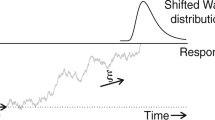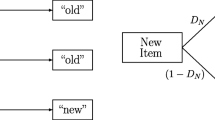Abstract
This paper provides a statistical framework for estimating higher-order characteristics of the response time distribution, such as the scale (variability) and shape. Consideration of these higher order characteristics often provides for more rigorous theory development in cognitive and perceptual psychology (e.g., Luce, 1986). RT distribution for a single participant depends on certain participant characteristics, which in turn can be thought of as arising from a distribution of latent variables. The present work focuses on the three-parameter Weibull distribution, with parameters for shape, scale, and shift (initial value). Bayesian estimation in a hierarchical framework is conceptually straightforward. Parameter estimates, both for participant quantities and population parameters, are obtained through Markov Chain Monte Carlo methods. The methods are illustrated with an application to response time data in an absolute identification task. The behavior of the Bayes estimates are compared to maximum likelihood (ML) estimates through Monte Carlo simulations. For small sample size, there is an occasional tendency for the ML estimates to be unreasonably extreme. In contrast, by borrowing strength across participants, Bayes estimation “shrinks” extreme estimates. The results are that the Bayes estimators are more accurate than the corresponding ML estimators.
Similar content being viewed by others
References
Ahrens, J., & Dieter, U. (1974). Computer methods for sampling from gamma, beta, poisson and binomial distributions.Computing, 12, 223–246.
Ahrens, J., & Dieter, U. (1982). Generating gamma variates by a modified rejection technique.Communications of the Association for Computing Machinery (ACM), 25, 47–54.
Andrews, S., & Heathcote, A. (2001). Distinguishing common and task-specific processes in word identification: A matter of some moment.Journal of Experimental Psychology: Learning, Memory, & Cognition, 27, 514–544.
Ashby, F. G., Tien, J.-Y., & Balikrishnan, J.D. (1993). Response time distributions in memory scanning.Journal of Mathematical Psychology, 37, 526–555.
Ashby, F. G., & Townsend, J.T. (1980). Decomposing the reaction time distribution: Pure insertion and selective influences revisited.Journal of Mathematical Psychology, 21, 93–123.
Balota, D.A., & Chumbley, J.I. (1984). Are lexical decisions a good measure of lexical access? The role of word frequency in the neglected decision stage.Journal of Experimental Psychology: Human Perception and Performance, 10, 340–357.
Balota, D.A., & Spieler, D.H. (1999). Word frequency, repetition, and lexicality effects in word recognition tasks: Beyond measures of central tendency.Journal of Experimental Psychology: General, 128, 32–55.
Berger, J.O., & Sun, D. (1993). Bayesian analysis for the poly-Weibull distribution.Journal of the American Statistical Association, 88, 1412–1418.
Bowman, K.O., & Shenton, L.R. (1988).Properties of estimators for the gamma distribution. New York, NY: Marcel Dekker.
Busemeyer, J.R., & Townsend, J.T. (1993). Decision field theory: A dynamic-cognitive approach to decision making in an uncertain environment.Psychological Review, 100, 432–459.
Cave, C., & Squire, L. (1992). Intact and long-lasting repetition priming in amnesia.Journal of Experimental Psychology: Learning, Memory, & Cognition, 18, 509–520.
Dey, D., Ghosh, S., & Mallick, B. (2000).Generalized linear models: A Bayesian perspective. New York, NY: Marcel Dekker.
Dolan, C., van der Maas, H., & Mollenaar, C. M. (in press). A framework for ML estimation of parameters of (mixtures of) common reaction time distributions given optional truncation or censoring.Behavioral Research Methods, Instruments, and Computers.
Dzhafarov, E.N. (1992). The structure of simple reaction time to step-function signals.Journal of Mathematical Psychology, 36, 235–268.
Fox, J.P., & Glas, C.A.W. (2001). Bayesian estimation of a multilevel IRT model using Gibbs sampling.Psychometrika, 66, 271–288.
Gelfand, A., & Smith, A.F.M. (1990). Sampling based approaches to calculating marginal densities.Journal of the American Statistical Association, 85, 398–409.
Gelman, A., Carlin, J.B., Stern, H.S., & Rubin, D.B. (1995).Bayesian data analysis. London, U.K.: Chapman and Hall.
Gelman, A., & Rubin, D.B. (1992). Inference from iterative simulation using multiple sequences (with discussion).Statistical Science, 7, 457–511.
Gilks, W. & Wild, P. (1992). Adaptive rejection sampling for Gibbs sampling.Applied Statistics, 41, 337–348.
Hasher, L., & Zacks, R.T. (1979). Automatic and effortful processes in memory.Journal of Experimental Psychology: General, 108, 356–388.
Heathcote, A. (1996). RTSYS: A DOS application for the analysis of reaction time data.Behavioral Research Methods, Instruments, and Computers, 28, 427–445.
Heathcote, A., Popiel, S. J., & Mewhort, D. J. (1991). Analysis of response time distributions: An example using the Stroop task.Psychological Bulletin, 109, 340–347.
Hockley, W.E. (1984). Analysis of reaction time distributions in the study of cognitive processes.Journal of Experimental Psychology: Learning, Memory, & Cognition, 10, 598–615.
Hohle, R.H. (1965). Inferred components of reaction time as a function of foreperiod duration.Journal of Experimental Psychology, 69, 382–386.
Hsu, Y.F. (1999).Two studies on simple reaction times: I. On the psychophysics of the generalized Pieron's law. II. On estimating minimum detection times using the time estimation paradigm. Unpublished doctoral dissertation. Irvine, CA: University of California.
Jacoby, L.L. (1991). A process dissociation framework: Separating automatic fromm intentional uses of memory.Journal of Memory and Language, 30, 513–541.
Jiang, Y., Rouder, J.N., & Speckman, P.L. (in press). A note on the sampling properties of the Vincentizing (quantile averaging) procedure.Journal of Mathematical Psychology.
Johnson, N.L., Kotz, S., & Balakrishnan, N. (1994).Continuous univariate distributions, Volume 2 (2nd ed.). New York, NY: John Wiley & Wiley.
Kreft, I.G.G., & de Leeuew, J. (1998).Introducing multilevel modeling. London, U.K.: Sage.
Link, S.W. (1975). The relative judgement theory of two choice response time.Journal of Mathematical Psychology, 12, 114–135.
Logan, G.D. (1988). Towards an instance theory of automization.Psychological Review, 95, 492–527.
Logan, G.D. (1992). Shapes of reaction time distributions and shapes of learning curves: A test of the instance theory of automaticity.Journal of Experimental Psychology: Learning, Memory, & Cognition, 18, 883–914.
Luce, R.D. (1986).Response times. New York, NY: Oxford University Press.
Madden, D.J., Gottlob, L.R., Denny, L.L., Turkington, T.G., Provenzale, J.M., Hawk, T.C., & Coleman, R.E. (1999). Aging and recognition memory: Changes in regional cerebral blood flow associated with components of reaction time distributions.Journal of Cognitive Neuroscience, 11, 511–520.
Mitchell, D. & Brown, A. (1988). Persistent repetition priming in picture naming and its dissociation from recognition memory.Journal of Experimental Psychology: Learning, Memory, & Cognition, 14, 213–222.
Nelder, J.A., & Mead, R. (1965). A simplex method for function minimization.Computer Journal, 7, 308–313.
Petrusic, W.M., Baranski, J.V., & Kennedy, R. (1999). Similarity comparisons with remembered and perceived magnitudes: Memory psychophysics and fundamental measurement.Memory & Cognition, 26, 1041–1055.
Plourde, C.E., & Besner, D. (1997). On the locus of the word frequency effect in visual word recognition.Canadian Journal of Experimental Psychology, 51, 181–194.
Posner, M.I. (1978).Chronometric explorations of the mind. Hillsdale, NJ: Lawrence Erlbaum Associates.
Press, W.H., Teukolsky, S.A., Vetterling, W.T., & Flannery, F.P. (1992).Numerical recipes in C: The art of scientific computing (2nd ed.). Cambridge, England: Cambridge University Press.
Ratcliff, R. (1978). A theory of memory retrieval.Psychological Review, 85, 59–108.
Ratcliff, R. (1979). Group reaction time distributions and an analysis of distribution statistics.Psychological Bulletin, 86, 446–461.
Ratcliff, R., & Rouder, J.N. (1998). Modeling response times for decisions between two choices.Psychological Science, 9, 347–356.
Ratcliff, R., & Rouder, J. (2000). A diffusion model analysis of letter masking.Journal of Experimental Psychology: Human Perception and Performance, 26, 127–140.
Rouder, J.N. (1996). Premature sampling in random walks.Journal of Mathematical Psychology, 40, 287–296.
Rouder, J.N. (2000). Assessing the roles of change discrimination and luminance integration: Evidence for a hybrid race model of perceptual decision making in luminance discrimination.Journal of Experimental Psychology: Human Perception and Performance, 26, 359–378.
Rouder, J.N. (2001). Testing evidence accrual models by manipulating stimulus onset.Journal of Mathematical Psychology, 45, 334–354.
Schnieder, W., & Shiffrin, R.M. (1977). Controlled and automatic human information processing: I. Detection, search, and attention.Psychological Review, 84, 1–66.
Smith, P.L. (1995). Multiple detector models of visual simple reaction time.Psychological Review, 102, 567–593.
Smith, R.L., & Naylor, J.C. (1987). A comparison of maximum likelihood and Bayesian estimators for the three-parameter Weibull distribution.Applied Statistician, 36, 358–369.
Spieler, D.H., Balota, D.A., & Faust, M.E. (1996). Stroop performance in healthy younger and older adults and in individuals with dementia of the Alzheimer's type.Journal of Experimental Psychology: Human Perception and Performance, 22, 461–479.
Spieler, D.H., Balota, D.A., & Faust, M.E. (2000). Levels of selective attention revealed through analyses of response time distributions.Journal of Experimental Psychology: Human Perception and Performance, 26, 506–526.
Sternberg, S. (1966). High-speed scanning in human memory.Scuebce, 153, 652–654.
Tanner, M.A. (1993).Tools for statistical inference: Methods for the exploration of posterior distributions and likelihood functions. Berlin, Germany: Springer.
Thomas, E.A.C., & Ross, B. (1980). On appropriate procedures for combining probability distributions within the same family.Journal of Mathematical Psychology, 21, 136–152.
Townsend, J.T., & Ashby, F.G. (1983).Stochastic modeling of elementary psychological processes. Cambridge, U.K.: Cambridge University Press.
Treisman, A.M., & Gelade, G. (1980). A feature-integration theory of attention.Cognitive Psychology, 12, 97–136.
Ulrich, R., & Miller, J.O. (1993). Information processing models generating lognormally distributed reaction times.Journal of Mathematical Psychology, 37, 513–525.
Van Zandt, T. (2000). How to fit a response time distribution.Psychonomic Bulletin and Review, 7, 424–465.
Van Zandt, T., Colonius, H., & Proctor, R. W. (2000). A comparison of two response time models applied to perceptual matching.Psychonomic Bulletin and Review, 7, 208–256.
Vincent, S.B. (1912). The function of vibrissae in the behavior of the white rat.Behavioral Monographs, 1, No. 5.
Wang, X.H., Bradlow, E.T., & Wainer, H. (2002). A general Bayesian model for testlets: Theory and applications.Applied Psychological Measurement, 26, 109–128.
Wild, P., & Gilks, W.R. (1993). Adaptive rejection sampling from log-concave density functions.Applied Statistics, 42, 701–708.
Wixted, J.T., & Rohrer, D. (1993). Proactive interference and the dynamics of free recall.Journal of Experimental Psychology: Learning, Memory, & Cognition, 19, 1024–1039.
Author information
Authors and Affiliations
Corresponding author
Additional information
We are grateful to Michael Stadler who allowed us use of his data. This research is supported by (a) National Science Foundation Grant SES-0095919 to J. Rouder, D. Sun, and P. Speckman, (b) University of Missouri Research Board Grant 00-77 to J. Rouder, (c) National Science Foundation grant DMS-9972598 to Sun and Speckman, and (d) a grant from the Missouri Department of Conservation to D. Sun.
Rights and permissions
About this article
Cite this article
Rouder, J.N., Sun, D., Speckman, P.L. et al. A hierarchical bayesian statistical framework for response time distributions. Psychometrika 68, 589–606 (2003). https://doi.org/10.1007/BF02295614
Received:
Revised:
Issue Date:
DOI: https://doi.org/10.1007/BF02295614




